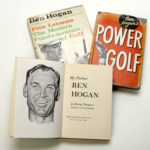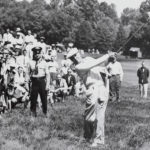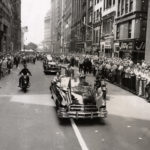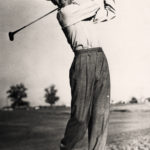
William Ben Hogan (2019)
About William Ben Hogan (2019)
The outline of the life and career of Ben Hogan are familiar to everyone: Growing up in Texas; family jolted by his father’s suicide; starts caddieing at age 11 in Fort Worth, where he meets fellow-looper Byron Nelson; shows great promise in his first years on the pro tour, but is fighting a hook; after endless hours of practice finds “the secret” and becomes the tour’s leading money winner and ultimately a major champion before a near-fatal auto accident interrupts his rise; makes a phenomenal comeback just a year later, winning the U.S. Open at Merion, and then two of the next three U.S. Opens; is honored with a tickertape parade in Manhattan in 1953 after winning the Masters, U.S. Open, and the only British Open he ever played; 63 tour victories, nine major championships, and one of five golfers to win all four majors (Sarazen, Nicklaus, Player, Woods).
Less well-known is the place of the Met Area in his formative years in the game. It was his misfortune to be a contemporary of the affable Byron Nelson; the two were in constant competition for tournaments and club-pro jobs, which were vital in the days when the leading money winners earned less than $10,000. They were both born in 1912, but Nelson was always a step or two ahead of Hogan: he won tournaments sooner, won majors sooner, was hired for prestige positions sooner. Nelson moved to the Met Area for an assistant pro job at Ridgewood Country Club in 1935; a year later, he won the Met Open at Quaker Ridge, and his first major title, the Masters, in 1937. As for Hogan, in the beginning of 1938 he was living the itinerant playing pro life, barely covering his expenses. His best professional job was at a scuffling nine-hole course in Texas, which allowed him plenty of time to practice. Century Country Club in Purchase, N.Y., was looking for an assistant, heard about Hogan who was playing tournaments in California, and asked the brother of a former member out there to interview him. Hogan passed the inspection, and took the job that paid $500 a year plus food and lodging.
It is hard to imagine now, but Hogan had a reputation as a player of enormous ability who couldn’t win. Coming to the Met Area gave him a steady stream of competitive events through the summer, with many of the game’s top stars working at clubs in the region: Nelson, Gene Sarazen (Fresh Meadow), Craig Wood (Winged Foot), Paul Runyan (Metropolis), and many others. He did a great deal of teaching, he later wrote, which gave him the opportunity to figure out what was effective and what wasn’t (though later Century head pro Nelson Long told writer John Coyne, “Whenever he played with a member he had the habit of looking away when the member swung, so as not to be influenced by a bad swing.”). He practiced for hours a day, which was extremely unusual at the time. His game developed and his results improved: he finished in the money in the Met Open in 1938 (T7), 1939 (T8), and 1940 (solo second). He won his first tour title, a team event in Hershey, Pa., paired with Deal, N.J., pro Vic Ghezzi in 1938; in 1939 he made the cut in the U.S. Open for the first time.
His big breakthrough came in 1940, a year in which he was elevated to head professional at Century. He won the Westchester Open, Westchester PGA, and four tour events including the prestigious North & South in Pinehurst. He was the tour’s leading money winner for the first of three straight years in 1940, when he also won the Vardon Trophy for having the lowest scoring average. His first major championship was still six years away – two of which he spent in the U.S. Army Air Forces – but the Ben Hogan we know today had arrived.
In 1941 Hogan accepted the post of head professional at Hershey Country Club. He would never again work in the Met Area, but the swing principles and fundamentals that he worked out on the range at Century stayed with him and became an essential part of his greatness and his legacy.
Leaving his mark on the Met Area. . .
In 1938, Hogan took a job as an assistant pro at Century Country Club in Purchase, N.Y. He was a regular competitor in the Met Open and other local events, competing against names such as San Sneak, Byron Nelson, and Gene Sarazen. Hogan won the Westchester Open at Mount Vernon in 1940 and the 1940 Westchester PGA Championship (Met PGA). He became head professional at Century in 1940 where he worked through the summer.
NOTEWORTHY STATISTICS
Winner
Westchester Open, 1940
Winner
Westchester PGA, 1940
Runner-up
Met Open, 1940
ADDITIONAL DETAILS & MULTIMEDIA
Life Events
- Date of Birth: August 13, 1912
- Date of Death: July 25, 1997 (Age 84)
- Year Turned Professional: 1930 (Age 17 )
- Hometown: Dublin, Texas
- Club Affiliation: Century Country Club
Achievements
- 63 total professional wins, 9 Major wins (2 Masters, 4 U.S. Open, 1 Open Championship, 2 PGA Championship)
- One of 5 players ever to win all four majors
- 4x PGA Tour Player of the Year (1948,1950,1951,1953)
- World Golf Hall of Fame, Pinehurst Category, Class of 1974





